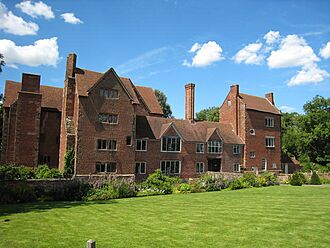Harvington Hall facts for kids
Quick facts for kids Harvington Hall |
|
|---|---|
 |
|
| General information | |
| Type | stately home |
| Location | Chaddesley Corbett, Worcestershire |
| Country | England |
| Coordinates | 52°22′04″N 2°10′51″W / 52.36778°N 2.18083°W |
| Owner | Roman Catholic Archdiocese of Birmingham |
Harvington Hall is a very old and interesting house in Worcestershire, England. It's a special kind of house called a manor house, and it's surrounded by a moat (a ditch filled with water). This historic building has parts that are from the Middle Ages and also from the time of Queen Elizabeth I.
Today, you can visit Harvington Hall and explore its secrets!
Contents
The Story of Harvington Hall
Harvington Hall has a long and fascinating history. Its moat, which is like a water-filled ditch around the house, and the island it sits on, were first built way back in the 1200s. Much of the house you see today was built in the 1300s. The main part of the Hall was likely the "solar," a private living room in a large timber-framed house.
Early Owners of the Hall
A man named Adam de Harvington lived here in the 1300s. He was an important person, working as the Chancellor of the Exchequer. This job meant he managed the country's money. Adam probably died at the Hall in 1344.
After Adam, the estate went to the Earl of Warwick. Then, in 1529, a rich lawyer named Sir John Pakington bought the Hall.
Humphrey Pakington and Secret Hides
Sir John Pakington's great-nephew, Humphrey Pakington, took over the Hall in 1578. Humphrey made many changes to the house, adding the special features we see today.
Harvington Hall is quite large now, but it used to be even bigger! Two of its wings (sections of the building) were taken down around the year 1700.
Humphrey Pakington was a Catholic during a difficult time in England. Queen Elizabeth I had strict laws against Catholics. These were called penal laws. Humphrey was a "recusant," meaning he refused to follow the rules of the Church of England. For example, he wouldn't go to their Sunday church services. This refusal cost him a lot of money.
In 1585, it became illegal for Catholic priests to even be in England. Because of this, Humphrey built many secret hiding places in the Hall. These were called priest holes or "priest hides." They were made to protect Catholic priests and followers from being caught.
These secret priest holes are still at Harvington Hall today. Some of the most famous ones were built by a master carpenter named Nicholas Owen. He was a Jesuit lay brother, which means he was part of a religious order but not a priest.
Later Years and Restoration
Humphrey Pakington died in 1631. He left the Hall to his wife, Abigail. When Abigail passed away in 1657, her daughter, Lady Mary Yate, inherited it. Lady Mary lived at the Hall until she was 85, passing away in 1696.
Her granddaughter, also named Mary Yate, inherited the Hall next. This Mary was married to Sir Robert Throckmorton. Sir Robert already had a large home, so he didn't need Harvington Hall. He decided to take down two of its wings.
In the 1800s and early 1900s, many of the Hall's furnishings were removed. The house became quite empty and run-down. Even an oak staircase was taken and moved to another house called Coughton Court.
In 1923, a kind woman named Mrs. Ellen Grant Ferris bought Harvington Hall. She then gave it to the Roman Catholic Archdiocese of Birmingham. This gift helped save the Hall. Mrs. Ferris's son, Robert Grant Ferris, later became an important politician.
In 1958, Harvington Hall and its nearby east bridge were given a special status. They were listed as a Grade I listed building, meaning they are very important historically. In 2001, a garden was replanted next to the moat. It includes medicinal herbs that were mentioned in old letters from the Elizabethan era.
See also

